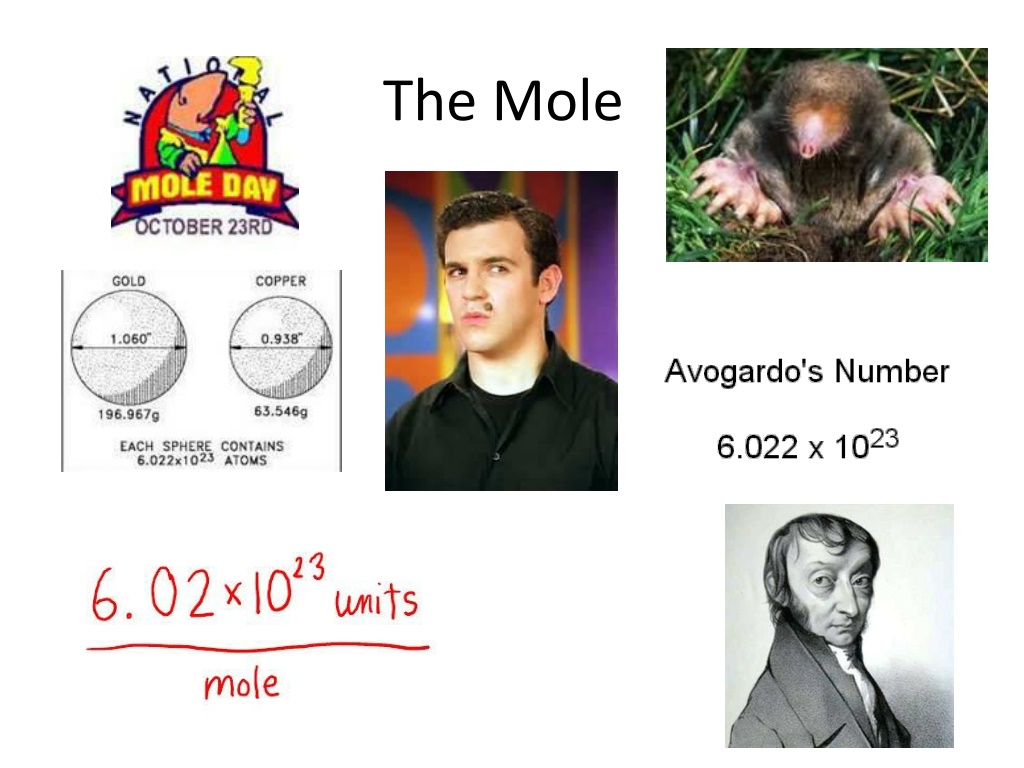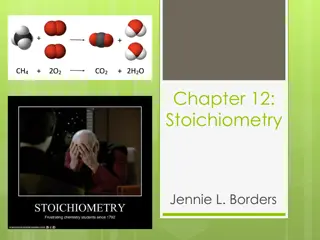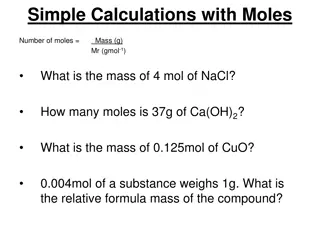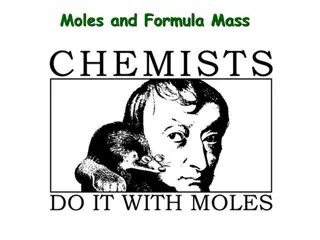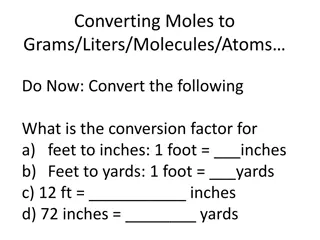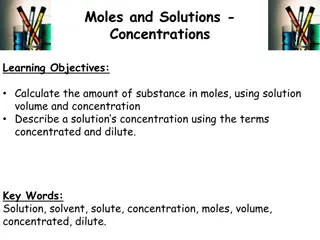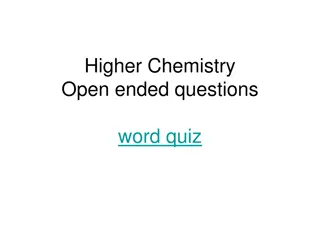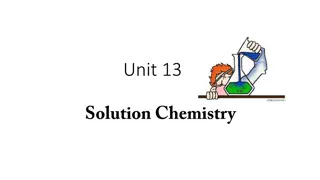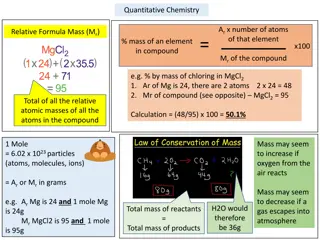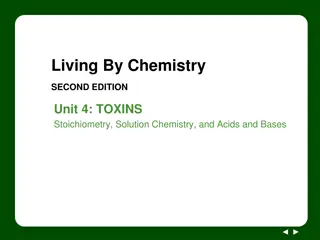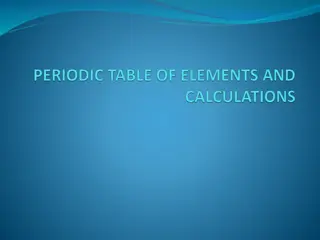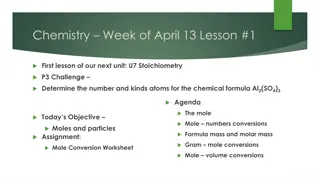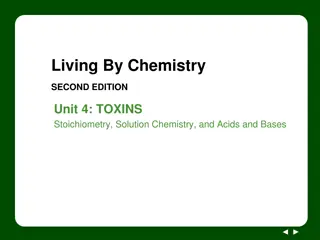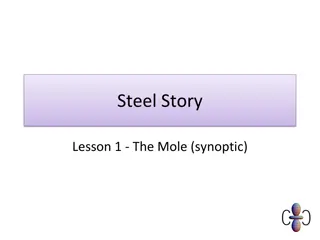Understanding Moles in Chemistry
Matter is composed of various particles, and chemists use the concept of moles as a unit of measure to quantify the number of particles in a substance. One mole is equal to 6.02 x 10^23 representative particles of a substance, known as Avogadro's number. Moles are versatile and applicable to different types of bonding arrangements, including atoms, molecules, and formula units. The International Union of Pure and Applied Chemistry (IUPAC) defines a mole as the amount of substance that contains as many elementary entities as there are atoms in 0.012 kilograms of carbon-12. Chemists use moles to work with masses of chemicals and calculate the number of atoms, molecules, or formula units involved in reactions. Additionally, molar mass, both gram-atomic and gram-molecular, is crucial for understanding the relative masses of elements in compounds.
Download Presentation

Please find below an Image/Link to download the presentation.
The content on the website is provided AS IS for your information and personal use only. It may not be sold, licensed, or shared on other websites without obtaining consent from the author. Download presentation by click this link. If you encounter any issues during the download, it is possible that the publisher has removed the file from their server.
E N D
Presentation Transcript
How do we measure the amount of a substance? Matter is made of different kinds of particles. We count the number of particles of that substance. Since there are a very large number of particles in any substance, we need to define a unit of measure: 1 mole = 6.02 x 1023representative particles of a substance. That number, which is experimentally determined, is called Avagadro s number.
Moles Work for Any Type of Bonding There are various types of arrangements that atoms can take: Individual atoms (metallic bonding, noble gases) Formula units or ions (ionic bonding) Molecules (covalent bonding)
A mole of any atom has 6.02 x 1023atoms A mole of any molecule has 6.02 x 1023molecules A mole of any formula unit has 6.02 x 1023formula units A mole of oranges has 6.02 x 1023oranges, etc.
Here is how the International Union of Pure and Applied Chemistry (IUPAC) defines "mole:" The mole is the amount of substance of a system that contains as many elementary entities as there are atoms in 0.012 kilogram of carbon-12. When the mole is used, the elementary entities must be specified and may be atoms, molecules, ions, electrons, other particles, or specified groups of such particles.
Working with any masses of chemicals In the laboratory, chemists may Need a certain amount of a reagent Isolate a product in chemical reaction Predict how much product will be produced for the amounts of reactants used. For all cases, chemists need to calculate the number of atoms, molecules and/or formula units that are involved.
Molar Mass (Gram Atomic Mass) The IUPAC definition of the mole aligns the measure of entities with the relative masses of the elements. For example: one mole of carbon = 12.011 g 12.011 g of carbon contains 6.02 x 1023atoms This is called the molar mass (gram atomic mass) of carbon.
Molar Mass (Gram Molecular Mass) For covalent compounds, you simply add the gram atomic masses of the individual elements to get a mole (6.02 x 1023molecules) For methane (CH4) + 4 12.0111 + 4(1.00794) = 16.0429 g Molar mass of methane
Molar Mass (Gram Formula Mass) The mole of an ionic compound is calculated like covalent molecules. For calcium chloride (CaCl2) + 2 40.08 + 2(35.453) = 110.986 g molar mass of CaCl2
Molar Mass Problems AlCl3 TeF4 Ba(SCN)2 NH4Cl Fe(OH)3 K2O
SnCrO4 (NH4)3PO4 NaHSO4 H2CO3 Ca(NO3)2 Pb(ClO2)2
Fractions of moles In practice, chemists rarely work with exactly one mole. The following equation (Table T) is used: A mass of a reagent is measured on a balance. To calculate moles, you have to first calculate the gram formula mass of the compound. Dividing the mass of the compound by the molar mass (GFM) yields moles.
32.0 grams O2 34.2 grams NH3 1.00 gram NaCl 14.0 grams N2
20.00 grams KOH 26.0 grams Ca(ClO4)2 2.50 grams Cr2CrO4 24.0 grams CO 50.0 grams KBr 11.0 grams CO2 10.0 grams V2O5 5.08 grams XeF4
Given Moles, Calculate Grams When the number of moles is known, it is easy to calculate the given mass by cross multiplication once the molar mass is known.
0.53 moles AlCl3 1.02 moles TeF4 54.0 moles Ba(SCN)2 0.20 moles NH4Cl
0.66 moles Fe(OH)3 1.15 moles K2O 0.213 moles SnCrO4 1.35 moles (NH4)3PO4 4.5 moles NaHSO4 0.003 moles H2CO3 3.3 moles Ca(NO3)2 0.05 moles Pb(ClO2)2
Mole-Mole Conversions Often chemists need to predict how much product will form with a given amount of reactants Alternatively, a chemist might need to know how much of a reactant is needed to make a certain amount of product. Using the chemical coefficients in the balanced equation, it is easy to calculate moles of anything.
Given the following reaction: 2H2+ O2? 2H2O How many moles of water are produced when 5.00 moles of oxygen are used? Set up a simple ratio: 5.00 mol O2* 2 mol H2O = 10.0 mol H2O 1 mol O2
2H2+ O2? 2H2O If 3.00 moles of water are produced, how many moles of oxygen must be consumed? Given the data in problem b), how many moles of hydrogen must be used?
2C2H6+ 7O2? 4CO2+ 6H2O How many moles of water will be produced from the complete combustion of 3.0 moles of ethane? How many moles of ethane are needed to produce 6.5 moles of carbon dioxide?
4Al + 3O2? 2Al2O3 What is the minimum number of moles of oxygen gas required to produce 1.00 mol of aluminum oxide? How many moles of aluminum are needed to produce 4.3 moles of aluminum oxide?
4Al + 3O2? 2Al2O3 You need to make 1 kg of aluminum oxide. How much aluminum and oxygen (in grams) do you need?
Ca + 2H2O ? Ca(OH)2+ H2 how many moles of water are required to react with 3.3 moles of calcium? how many grams of water are required to react with 3.3 moles of calcium?
Ca + 2H2O ? Ca(OH)2+ H2 How much hydrogen (in moles, and grams) is produced when 20 grams of calcium are placed in a beaker of water?
